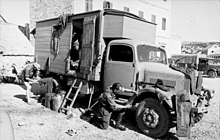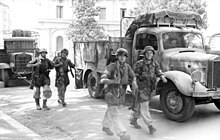Mercedes-Benz L 3000
| Mercedes Benz | |
|---|---|
|
L 3000 S
|
|
| L 3000 | |
| Manufacturer: | Daimler Benz |
| Sales designation: | L 3000 |
| Production period: | 1938-1944 |
| Previous model: | none |
| Successor: | none |
| Technical specifications | |
| Designs: | Cab-over-the-hood truck with various bodies |
| Engines: | OM 65 (diesel, 4849 cm³) |
| Power: | 55 kW |
| Length: | 6255 mm |
| Width: | 2350 mm |
| Height: | 2600 mm |
| Wheelbase: | 3800 mm |
| Turning circle: | ø 15.2 m |
| Payload: | 3.020 t |
| Perm. Total weight: | 7.040 t |
The Mercedes-Benz L 3000 is a two-axle truck made by the German manufacturer Daimler-Benz AG , which was produced from 1938 to 1944. From 1939 the models with rear-wheel drive were called the L 3000 S ; Models with all-wheel drive are called L 3000 A and were only built from 1939 to 1942.
History and background
Pre-models
From 1896, Daimler-Motoren-Gesellschaft built not only passenger cars but also light and heavy trucks with a payload of up to 10 t for the civil and military sectors. The Reichswehr also used 3-ton trucks as personnel carriers. Starting in 1934, Daimler-Benz manufactured some off-road test vehicles under the name Mercedes-Benz LG 63 , which after successful testing went into series production as the Mercedes-Benz LG 3000 and from 1936 were delivered to the Wehrmacht , Reichspost , Reichsbahn and commercial enterprises.
Mercedes-Benz L 3000
From 1938, the 3-tonne Mercedes-Benz L 3000 truck - known in-house as the LGF 3000 - was a road vehicle with a modern steel cab. In contrast to the usually gasoline-powered truck in its time of the L 3000 had a 4849 cc diesel engine with an engine power of 55 kW (75 HP) at 2250 min -1 .
At the start of the war in 1939, numerous L 3000s were drafted as part of the material mobilization supplement and used by the Wehrmacht. The Wehrmacht classified the L 3000 in the war strength reports as a "medium all-terrain truck, open (o)" , which was given different superstructures and upgrade kits depending on the intended use.
For reasons of rationalization, the German truck manufacturers were instructed on January 1, 1940 to concentrate on the completion of standard trucks instead of the previous large variety of types. The L 3000 types were now supplied as “standard trucks” under the names Mercedes-Benz L 3000 S (3000 = 3.0 t; S = standard) and Mercedes-Benz L 3000 A (A = all-wheel drive).
Production of the L 3000 was stopped in 1944 after the Brandenburg Opel factory ceased to be a producer due to an air raid at the beginning of August 1944 and Daimler-Benz was now the sole manufacturer of the Opel "Blitz" 3.6, which was important for the war effort . Its license production at the Daimler-Benz truck plant in Mannheim had only started shortly before. In addition to the L 3000 and the 3-to-Opel “Blitz”, Daimler-Benz manufactured numerous other size classes, most of which were used by the Wehrmacht.
Other truck types up to 1945
The Mercedes-Benz L 4500 S / A , which was designed as a 4.5 t truck, was developed in the same way, some of which were also built as a mule half-track vehicle using chassis from the Panzer II . Lighter trucks of the types Mercedes-Benz L 1100 , Mercedes-Benz L 1500 S / A and Mercedes-Benz L 2000 L (= light) were also delivered. The only difference between the standard trucks and the previous models was their rounded fenders. From 1943 onwards, civilian trucks were mostly equipped with a wood gasification system, as the scarce gasoline was primarily supplied to the Wehrmacht. The wooden driver's cab customary for standard trucks was later used.
technology
The L 3000 is a two-axle truck with a U-profile ladder frame , the rigid axles of which are suspended from semi-springs at the front and rear. The front axle has single tires, while the rear axle has double tires. The tires are all around tires in size 7.50-20; the L 3000 A has tires with an off-road profile. The brake system is hydraulically operated and acts on all wheels, the handbrake acts on the rear wheels. A type 700 Ross steering system from ZF is used for steering . The power is transmitted from the engine to a manual five-speed gearbox with a countershaft via a dry single-plate clutch . With the off-road type L 3000 A, the power comes from the transmission to the front and rear wheels via three locking differentials. The front-wheel drive can be switched off, the off-road gear can also be switched on without the front-wheel drive switched on.
The engine is the Mercedes-Benz OM 65/4. It is a four-cylinder series - antechamber - diesel engine with Overhead valves and water cooling . The crankshaft has five bearings and drives the camshaft below via spur gears. The fuel is injected into the prechambers by a Deckel or Bosch injection pump .
Technical data L 3000 A
| L 3000 A | |
|---|---|
| Dimensions and weights | |
| length | 6255 mm |
| width | 2350 mm |
| height | 2600 mm |
| wheelbase | 3800 mm |
| Front track | 1633 mm |
| Rear track | 1650 mm |
| Ground clearance | 225 mm |
| Wading ability | 700 mm |
| Turning circle diameter | 15.2 m |
| Empty weight | 4020 kg |
| payload | 3020 kg (2600 kg) |
| Max. Permissible total mass | 7040 kg (6620 kg) |
| other data | |
| Top speed | 70 km / h |
| Fuel consumption | 20 l / 100 km (30 l / 100 km) |
| Capacity of the fuel tank | 90 l diesel fuel |
| battery | 2 × 12 V, 90 Ah |
| Power transmission | |
| coupling | Single-disc dry clutch |
| transmission | Five-speed gearbox with countershaft |
| tires | 7.50-20 off-road tires |
| Power transmission on | all wheels |
| engine | |
| designation | OM 65/4 |
| Engine type | In-line four-cylinder pre-chamber diesel engine |
| cooling | water |
| Valve train | OHV valve control |
| Bore × stroke | 105 × 140 mm |
| Displacement | 4849 cc |
| Compression ratio | 20: 1 |
| rated capacity | 55 kW (75 HP) at 2250 min -1 |
| Torque at nominal power | 234 Nm at 2250 min -1 |
() Values in brackets apply to off-road driving
Quantities
| L 3000 | 3.00 t | 1938-1939 | 12,840 |
| L 3000 S | 3.00 t | 1939-1944 | 18,356 |
| L 3000 A | 3.00 t | 1940-1942 | 2,069 |
| source | |||
See also
literature
- Werner Oswald : Motor vehicles and tanks of the Reichswehr, Wehrmacht and Bundeswehr . Motorbuch Verlag, Stuttgart 1982.
- Frank, Reinhard: Mercedes in the war - passenger cars, trucks, special bodies. PODZUN-PALLAS-VERLAG, Dornheim. 1985. ISBN 3-7909-0244-6 .
Web links
- Restoration of a Mercedes-Benz L 3000 S, March 18, 2012
Individual evidence
- ↑ cf. Engine output March 18, 2012
- ↑ cf. Production figures March 18, 2012
| Vehicle class | 1920s | 1930s | 1940s | ||||||||||||||||
| 6th | 7th | 8th | 9 | 0 | 1 | 2 | 3 | 4th | 5 | 6th | 7th | 8th | 9 | 0 | 1 | 2 | 3 | 4th | |
| Compact class | W 15 (type 170) | ||||||||||||||||||
| W 23 (type 130) | |||||||||||||||||||
| W 30 (type 150) | |||||||||||||||||||
| W 28 (type 170 H) | |||||||||||||||||||
| Middle class | W 02 (type Stuttgart 200) | W 136 / W 149 (types 170 V / 200 V) | |||||||||||||||||
| W 11 (type Stuttgart 260) | W 143 (type 230 n) | ||||||||||||||||||
| W 21 (type 200/230) | W 153 (type 230) | ||||||||||||||||||
| W 138 (type 260 D) | |||||||||||||||||||
| upper middle class | W 03 / W 04 / W 05 (types 300/320/350) | W 18 (type 290) | |||||||||||||||||
| W 10 / W 19 (types 350/370/380) | W 142 (type 320) | ||||||||||||||||||
| W 22 | |||||||||||||||||||
| Upper class | Type 400 & Type 630 | W 24 / W 29 / W 129 (types 500 K / 540 K / 580 K) | |||||||||||||||||
| W 08 (type Nürburg 460/460 K / 500 / type 500 N) | |||||||||||||||||||
| W 07 / W 150 (types 770/770 K) | |||||||||||||||||||
| Sports car | Model K | ||||||||||||||||||
| W 06 (type S / SS / SSK / SSKL) | W 24 / W 29 / W 129 | ||||||||||||||||||
| Off-road vehicle | W 103 (type G1) | W 31 (type G4) | |||||||||||||||||
| W 133 III (type 170 VG) / W 139 (type 170 VL) / W 152 (type G5) | |||||||||||||||||||
| Vans | L 3/4 | L 1000 Express | L 301 | ||||||||||||||||
| L 300 | |||||||||||||||||||



